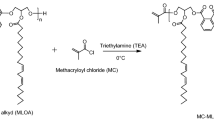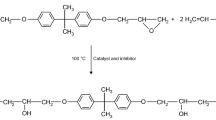Abstract
The effect of relative humidity on the curing of alkoxysilane functional alkyds and reactive diluents was evaluated. Alkoxysilane functional alkyds and tung oil-based reactive diluents were synthesized and used as additives in varying amounts in alkyd coatings. Looking at modified alkyd versus modified reactive diluent allows for the comparison of the humidity effect on high and low molecular weight alkoxysilane functional additives. The coatings were cured at 25 and 75% relative humidity and evaluated for drying time, coating and tensile properties, and gel content. It was found that at higher humidity, the alkoxysilane-containing samples improved properties significantly when compared to the control alkyd.










Similar content being viewed by others
References
Weiss, KD, Paint and Coatings: A Mature Industry in Transition. Prog. Polym. Sci. 22 (2) 203–245. https://doi.org/10.1016/S0079-6700(96)00019-6 (1997)
Ren, X, Meng, L, Soucek, M, Environmentally Friendly Coatings. In: Tiwari, A, Galanis, A, Soucek, MD (eds.) Biobased and Environmental Benign Coatings, Wiley, Hoboken, pp. 183–223. https://doi.org/10.1002/9781119185055.ch8 (2016)
Hofland, A, Alkyd Resins: From Down and Out to Alive and Kicking. Prog. Org. Coat. 73 (4) 274–282. https://doi.org/10.1016/j.porgcoat.2011.01.014 (2012)
Kobayashi, S, Müllen, K (eds) Encyclopedia of Polymeric Nanomaterials. Springer Berlin Heidelberg, Berlin Heidelberg. https://doi.org/10.1007/978-3-642-29648-2 (2015)
Holmberg, K, High Solids Alkyd Resins. Marcel Dekker Inc, New York. (1987)
Wicks, ZW (ed) Organic Coatings: Science and Technology, 3rd edn. Wiley-Interscience, Hoboken, NJ (2007)
Sailer, RA, Soucek, MD, Oxidizing Alkyd Ceramers. Prog. Org. Coat. 33 (1) 36–43. https://doi.org/10.1016/S0300-9440(98)00005-8 (1998)
Sailer, RA, Soucek, MD, Viscoelastic Properties of Alkyd Ceramers. J. Appl. Polym. Sci. 73 (10) 2017–2028. https://doi.org/10.1002/(SICI)1097-4628(19990906)73:10%3c2017::AID-APP20%3e3.0.CO;2-1 (1999)
Pathan, S, Ahmad, S, Synergistic Effects of Linseed Oil Based Waterborne Alkyd and 3-Isocynatopropyl Triethoxysilane: Highly Transparent, Mechanically Robust, Thermally Stable, Hydrophobic Anticorrosive Coatings. ACS Sustain. Chem. Eng. 4 (6) 3062–3075. https://doi.org/10.1021/acssuschemeng.6b00024 (2016)
Wen, J, Wilkes, GL, Organic/Inorganic Hybrid Network Materials by the Sol−Gel Approach. Chem. Mater. 8 (8) 1667–1681. https://doi.org/10.1021/cm9601143 (1996)
Zvonkina, I, Soucek, M, Inorganic-Organic Hybrid Coatings: Common and New Approaches. Curr. Opin. Chem. Eng. 11, 123–127. https://doi.org/10.1016/j.coche.2016.01.008 (2016)
Wang, D, Bierwagen, GP, Sol–Gel Coatings on Metals for Corrosion Protection. Prog. Org. Coat. 64 (4) 327–338. https://doi.org/10.1016/j.porgcoat.2008.08.010 (2009)
Tohge, N, “Formation of SiO2-Based Coatings by the Sol–Gel Method and Their Effects on Water Vapour Permeability of Polyimide Films.” 3.
Teng, G, Soucek, MD, Epoxidized Soybean Oil-Based Ceramer Coatings. J. Am. Oil Chem. Soc. 77 (4) 381–387. https://doi.org/10.1007/s11746-000-0062-0 (2000)
Zou, K, Soucek, MD, UV-Curable Organic-Inorganic Hybrid Film Coatings Based on Epoxidized Cyclohexene Derivatized Linseed Oil. Macromol. Chem. Phys. 205 (15) 2032–2039. https://doi.org/10.1002/macp.200400115 (2004)
Ni, H, Skaja, AD, Sailer, RA, Soucek, MD, Moisture-Curing Alkoxysilane-Functionalized Isocyanurate Coatings. Macromol. Chem. Phys. 201 (6) 722–732. https://doi.org/10.1002/(SICI)1521-3935(20000301)201:6%3c722::AID-MACP722%3e3.0.CO;2-D (2000)
Gilberts, J., Tinnemans, AHA, Hogerheide, MP, Koster, TPM, “UV Curable Hard Transparent Hybrid Coating Materials on Polycarbonate Prepared by the Sol–Gel Method”. 7.
Danks, AE, Hall, SR, Schnepp, Z, The Evolution of ‘Sol–Gel’ Chemistry as a Technique for Materials Synthesis. Mater. Horiz. 3 (2) 91–112. https://doi.org/10.1039/C5MH00260E (2016)
Hench, LL, West, JK, The Sol–Gel Process. Chem. Rev. 90 (1) 33–72. https://doi.org/10.1021/cr00099a003 (1990)
Brinker, CJ, Scherer, GW, Sol–Gel Science: The Physics and Chemistry of Sol–Gel Processing. Academic Press. (2013)
Young, SK, Overview of Sol–Gel Science and Technology. ARL-TR-2650; Army Research Laboratory (2002)
Brinker, CJ, Hydrolysis and Condensation of Silicates: Effects on Structure. J. Non-Cryst. Solids 100 (1–3) 31–50. https://doi.org/10.1016/0022-3093(88)90005-1 (1988)
Brinker, C, Frye, G, Ashley, C, Smith, D, Davis, P, Hietala, S, “Sol–Gel Routes to Controlled Pore-Size Amorphous Oxides.” In: Abstracts of Papers of the American Chemical Society; Amer. Chemical Soc, Washington, DC 20036, Vol. 201, pp 348–INOR (1991)
Brinker, CJ, Hurd, AJ, Schunk, PR, Frye, GC, Ashley, CS, Review of Sol–Gel Thin Film Formation. J. Non-Cryst. Solids 147–148, 424–436. https://doi.org/10.1016/S0022-3093(05)80653-2 (1992)
Wold, CR, Soucek, MD, Viscoelastic and Thermal Properties of Linseed Oil-Based Ceramer Coatings. Macromol. Chem. Phys. 201 (3) 382–392. https://doi.org/10.1002/(SICI)1521-3935(20000201)201:3%3c382::AID-MACP382%3e3.0.CO;2-9 (2000)
Teng, G, Wegner, JR, Hurtt, GJ, Soucek, MD, Novel Inorganic/Organic Hybrid Materials Based on Blown Soybean Oil with Sol–Gel Precursors. Prog. Org. Coat. 42 (1–2) 29–37. https://doi.org/10.1016/S0300-9440(01)00126-6 (2001)
Tuman, SJ, Soucek, MD, Novel Inorganic/Organic Coatings Based on Linseed Oil and Sunflower Oil with Sol–Gel Precursors. JCT J. Coat. Technol. 68, 854 (1996)
Wold, CR, Soucek, MD, Mixed Metal Oxide Inorganic/Organic Coatings. J. Coat. Technol. 70 (7) 43–51. https://doi.org/10.1007/BF02720514 (1998)
Baghdachi, J, Li, D, LaForest, J, Isocyanate-Free Moisture Cure Coatings. J. Coat. Technol. 74 (9) 81–87. https://doi.org/10.1007/BF02697977 (2002)
Chang, W-H, Hartman, ME, Scriven, RL, “Ambient Temperature, Moisture-Curable Acrylic-Silane Coating Compositions Having Improved Potlife.” US Patent 4,043,953, August 23, 1977
Emmerling, W, Padola, T, Unger, L, Majolo, M, “Moisture-Curing Alkoxysilane-Terminated Polyurethanes.” US Patent 5,554,709, September 10, 1996
Ni, H, Skaja, AD, Soucek, MD, Acid-Catalyzed Moisture-Curing Polyurea/Polysiloxane Ceramer Coatings. Prog. Org. Coat. 40 (1–4) 175–184. https://doi.org/10.1016/S0300-9440(00)00116-8 (2000)
D01 Committee. Test Methods for Acid Value of Organic Coating Materials; D 1639-90; ASTM International (1996)
D01 Committee. Test Methods for Hydroxyl Value of Fatty Oils and Acids; D 1957-86; ASTM International (2001)
D01 Committee. Test Methods for Hardness of Organic Coatings by Pendulum Damping Tests; D 4366-16; ASTM International. https://doi.org/10.1520/D4366-16
D01 Committee. Test Method for Film Hardness by Pencil Test; D 3363-05; ASTM International. https://doi.org/10.1520/D3363-05R11E02
D01 Committee. Test Method for Pull-Off Strength of Coatings Using Portable Adhesion Testers; D 4541-17; ASTM International. https://doi.org/10.1520/D4541-17
Salata, RR, Pellegrene, B, Soucek, MD, "Synthesis and Properties of a High Solids Triethoxysilane-Modified Alkyd Coatings." Prog. Org. Coat., 133 340–349 (2019)
Wutticharoenwong, K, Soucek, MD, Synthesis of Tung-Oil-Based Reactive Diluents. Macromol. Mater. Eng. 295 (12) 1097–1106. https://doi.org/10.1002/mame.201000099 (2010)
Wutticharoenwong, K, Dziczkowski, J, Soucek, MD, Tung Based Reactive Diluents for Alkyd Systems: Film Properties. Prog. Org. Coat. 73 (4) 283–290. https://doi.org/10.1016/j.porgcoat.2011.03.017 (2012)
Schmidt, H, Scholze, H, Kaiser, A, Principles of Hydrolysis and Condensation Reaction of Alkoxysilanes. J. Non-Cryst. Solids 63, 1–11 (1984)
Greenbank, GR, Holm, GE, Some Factors Concerned in the Autoxidation of Fats. Ind. Eng. Chem. 16 (6) 598–601. https://doi.org/10.1021/ie50174a024 (1924)
Minemoto, Y, Adachi, S, Matsuno, R, "Effect of Relative Humidity During Storage on the Autoxidation of Linoleic Acid Encapsulated with a Polysaccharide by Hot-Air-Drying and Freeze-Drying." Food Sci. Technol. Res., 7 (1) 91–93. https://doi.org/10.3136/fstr.7.91 (2001)
Sinha, A, Islam Khan, N, Das, S, Zhang, J, Halder, S, Effect of Reactive and Non-Reactive Diluents on Thermal and Mechanical Properties of Epoxy Resin. High Perform. Polym. 30 (10) 1159–1168. https://doi.org/10.1177/0954008317743307 (2018)
Wool, RP, “Properties of Triglyceride-Based Thermosets.” In: Bio-Based Polymers and Composites
DiMarzio, EA, The Entropy Theory of Glass Formation after 40 Years. Comput. Mater. Sci. 4, 317–324 (1995)
DiMarzio, EA, The Glass Temperature of Polymer Blends. Polymer 31, 2294–2298 (1990)
DiMarzio, EA, On the Second-Order Transition of a Rubber. J. Res. Natl. Bur. Stand. Phys. Chem. 68A (6) 611–617 (1964)
DiMarzio, EA, Guttman, CM, The Glass Temperature of Polymer Rings. Macromolecules 20, 1403–1407 (1987)
Hale, A, Macosko, CW, Bair, HE, Glass Transition Temperature as a Function of Conversion in Thermosetting Polymers. Macromolecules 24 (9) 2610–2621. https://doi.org/10.1021/ma00009a072 (1991)
Arkles, B, Commercial Applications of Sol–Gel-Derived Hybrid Materials. MRS Bull. 26 (05) 402–408. https://doi.org/10.1557/mrs2001.94 (2001)
Author information
Authors and Affiliations
Corresponding author
Additional information
Publisher's Note
Springer Nature remains neutral with regard to jurisdictional claims in published maps and institutional affiliations.
Rights and permissions
About this article
Cite this article
Pellegrene, B., Soucek, M.D. Effect of humidity on curing of alkoxysilane-functionalized alkyd coatings. J Coat Technol Res 18, 1543–1555 (2021). https://doi.org/10.1007/s11998-021-00494-w
Received:
Revised:
Accepted:
Published:
Issue Date:
DOI: https://doi.org/10.1007/s11998-021-00494-w




